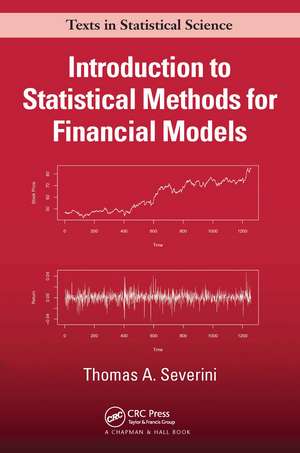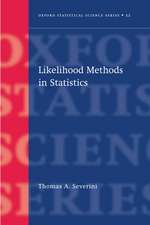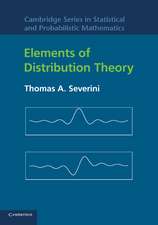Introduction to Statistical Methods for Financial Models: Chapman & Hall/CRC Texts in Statistical Science
Autor Thomas A Severinien Limba Engleză Paperback – 30 sep 2020
This book provides an introduction to the use of statistical concepts and methods to model and analyze financial data. The ten chapters of the book fall naturally into three sections. Chapters 1 to 3 cover some basic concepts of finance, focusing on the properties of returns on an asset. Chapters 4 through 6 cover aspects of portfolio theory and the methods of estimation needed to implement that theory. The remainder of the book, Chapters 7 through 10, discusses several models for financial data, along with the implications of those models for portfolio theory and for understanding the properties of return data.
The audience for the book is students majoring in Statistics and Economics as well as in quantitative fields such as Mathematics and Engineering. Readers are assumed to have some background in statistical methods along with courses in multivariate calculus and linear algebra.
| Toate formatele și edițiile | Preț | Express |
|---|---|---|
| Paperback (1) | 314.14 lei 6-8 săpt. | |
| CRC Press – 30 sep 2020 | 314.14 lei 6-8 săpt. | |
| Hardback (1) | 684.99 lei 6-8 săpt. | |
| CRC Press – 12 iul 2017 | 684.99 lei 6-8 săpt. |
Din seria Chapman & Hall/CRC Texts in Statistical Science
- 5%
 Preț: 650.11 lei
Preț: 650.11 lei - 9%
 Preț: 579.76 lei
Preț: 579.76 lei - 8%
 Preț: 547.81 lei
Preț: 547.81 lei - 5%
 Preț: 838.33 lei
Preț: 838.33 lei - 9%
 Preț: 595.18 lei
Preț: 595.18 lei - 9%
 Preț: 623.03 lei
Preț: 623.03 lei - 8%
 Preț: 544.76 lei
Preț: 544.76 lei - 9%
 Preț: 641.61 lei
Preț: 641.61 lei - 8%
 Preț: 508.20 lei
Preț: 508.20 lei - 8%
 Preț: 551.99 lei
Preț: 551.99 lei - 9%
 Preț: 1115.11 lei
Preț: 1115.11 lei - 9%
 Preț: 641.93 lei
Preț: 641.93 lei -
 Preț: 341.43 lei
Preț: 341.43 lei - 8%
 Preț: 536.31 lei
Preț: 536.31 lei -
 Preț: 357.60 lei
Preț: 357.60 lei - 8%
 Preț: 444.54 lei
Preț: 444.54 lei - 9%
 Preț: 578.22 lei
Preț: 578.22 lei -
 Preț: 371.71 lei
Preț: 371.71 lei - 9%
 Preț: 806.41 lei
Preț: 806.41 lei - 9%
 Preț: 602.46 lei
Preț: 602.46 lei - 9%
 Preț: 593.61 lei
Preț: 593.61 lei - 9%
 Preț: 608.09 lei
Preț: 608.09 lei - 8%
 Preț: 496.58 lei
Preț: 496.58 lei - 9%
 Preț: 610.94 lei
Preț: 610.94 lei - 20%
 Preț: 541.42 lei
Preț: 541.42 lei -
 Preț: 355.66 lei
Preț: 355.66 lei - 8%
 Preț: 516.75 lei
Preț: 516.75 lei -
 Preț: 349.10 lei
Preț: 349.10 lei - 9%
 Preț: 568.64 lei
Preț: 568.64 lei - 8%
 Preț: 465.05 lei
Preț: 465.05 lei - 9%
 Preț: 580.81 lei
Preț: 580.81 lei - 9%
 Preț: 617.41 lei
Preț: 617.41 lei - 9%
 Preț: 595.91 lei
Preț: 595.91 lei -
 Preț: 388.08 lei
Preț: 388.08 lei -
 Preț: 356.64 lei
Preț: 356.64 lei - 8%
 Preț: 547.38 lei
Preț: 547.38 lei - 9%
 Preț: 599.19 lei
Preț: 599.19 lei -
 Preț: 316.73 lei
Preț: 316.73 lei - 9%
 Preț: 638.87 lei
Preț: 638.87 lei -
 Preț: 349.46 lei
Preț: 349.46 lei -
 Preț: 372.50 lei
Preț: 372.50 lei - 8%
 Preț: 439.81 lei
Preț: 439.81 lei - 11%
 Preț: 686.52 lei
Preț: 686.52 lei - 8%
 Preț: 510.14 lei
Preț: 510.14 lei - 8%
 Preț: 511.07 lei
Preț: 511.07 lei - 8%
 Preț: 563.73 lei
Preț: 563.73 lei - 18%
 Preț: 713.39 lei
Preț: 713.39 lei - 15%
 Preț: 684.84 lei
Preț: 684.84 lei - 22%
 Preț: 371.94 lei
Preț: 371.94 lei
Preț: 314.14 lei
Preț vechi: 357.50 lei
-12% Nou
Puncte Express: 471
Preț estimativ în valută:
60.12€ • 62.53$ • 49.63£
60.12€ • 62.53$ • 49.63£
Carte tipărită la comandă
Livrare economică 15-29 aprilie
Preluare comenzi: 021 569.72.76
Specificații
ISBN-13: 9780367657871
ISBN-10: 0367657872
Pagini: 386
Dimensiuni: 156 x 234 x 26 mm
Greutate: 0.54 kg
Ediția:1
Editura: CRC Press
Colecția Chapman and Hall/CRC
Seria Chapman & Hall/CRC Texts in Statistical Science
ISBN-10: 0367657872
Pagini: 386
Dimensiuni: 156 x 234 x 26 mm
Greutate: 0.54 kg
Ediția:1
Editura: CRC Press
Colecția Chapman and Hall/CRC
Seria Chapman & Hall/CRC Texts in Statistical Science
Cuprins
Returns.
Random Walk Hypothesis.
Portfolios.
Efficient Portfolio Theory.
Estimation.
Capital Asset Pricing Model.
The Market Model.
The Single-Index Model.
Factor Models.
Random Walk Hypothesis.
Portfolios.
Efficient Portfolio Theory.
Estimation.
Capital Asset Pricing Model.
The Market Model.
The Single-Index Model.
Factor Models.
Notă biografică
Thomas A. Severini is a professor of statistics at Northwestern University. He is a fellow of the American Statistical Association and the author of Likelihood Methods in Statistics and Elements of Distribution Theory. He received his PhD in statistics from the University of Chicago. His research areas include likelihood inference, nonparametric and semiparametric methods, and applications to econometrics.
Recenzii
"This will be an excellent textbook designed for more mathematically oriented undergraduates and masters students. A course out of this book could be offered by mathematics, statistics, economics, and engineering departments. Students will find that this book provides valuable preparation for a career in finance. Professor Severini is a distinguished researcher. His clearly-written book combines a theorem-proof style typical of mathematics texts with concrete examples that will aid students' understanding of key concepts. Many examples are done in R which has become a popular teaching tool for courses at all levels. Besides its use as a textbook for formal courses, this book will be valuable resource for self-study."
—David Ruppert, Cornell University
"Data-driven approaches to financial analysis have gained in prominence with the availability of high-performance computing and access to large databases. Balancing such a perspective with an accessible introduction to statistical theory is what sets this treatment apart. Throughout, a hands-on approach using R code and market data is used to explain both statistical concepts and to implement financial models. Thus, students may be able to grasp the theoretical underpinnings for analysis without feeling overwhelmed by them. This is a welcome addition to the Texts in Statistical Science series, and I will encourage my advanced undergraduate students to keep a copy close at hand."
—Afzal S. Siddiqui, Department of Statistical Science University College London and Department of Computer and Systems Sciences Stockholm University
"This book is both an exceptional introductory textbook and the essential desk reference for all students and practitioners of financial econometrics and quantitative finance with an interest in quantitative portfolio design and analysis. This well-written book begins with a deceptively simple introduction discussing financial data and its basic models together with how to estimate these models. It develops all the techniques required to estimate and apply the standard theoretical portfolio models, and includes R codes that help the reader understand the material and implement it on real datasets. It confronts the well-known instability of weight estimates in the Markowitz portfolio model head on and provides modern techniques for improving the required statistical estimates. These first seven chapters would, taken alone, represent the ideal book for a deep, rigorous one semester course on portfolio theory for senior undergraduate or graduate students in economics, actuarial science, or quantitative finance. Three more beautiful chapters remain, covering the Market Model, the Single-Index Model, and Factor Models. Each chapter ends with an insightful guided tour of other important books and papers in the area that allow deeper engagement with the material. It includes more than 150 questions which encourage students to develop theoretical familiarity with the concepts introduced, facility with the R computations required to apply these concepts, and the beginnings of the deep financial intuition about markets which the author clearly possesses."
— Matt Davison, Director, School of Mathematical & Statistical Sciences, Professor of Applied Mathematics and of Statistical & Actuarial Sciences, Western University Canada, London, Ontario
"The book covers basic statistical methods for the analysis of financial data and models. This includes the basic random walk hypothesis and Markowitz’ portfolio theory in Chapters 3 and 5 and the capital asset pricing model, the market model, the single index model and factor models in Chapters 7 to 10. For estimation the empirical estimators for mean and covariances are explained, and also weighted and shrinkage estimators, in Chapter 6. Also some model tests for the random walk hypothesis and the market model are described. Definitions and basic concepts are provided in Chapter 2, “Returns”, and Chapter 4, “Portfolios”.
The book is very easy to read. Each chapter starts with an introduction and then states the basic concepts always with some simple examples. In many cases these are given in terms of the statistical software “R”.
The theoretical statements are often formulated as theorems and propositions, of which some are stated without proofs. The proofs are basically on an elementary level, therefore of course lacking mathematical precision. This is also true for concepts like conditional expectation, martingales and filtrations, which are introduced on a less formal but quite intuitive level. At the end of each chapter the reader finds many exercises and suggestions for further reading.
In addition to the aforementioned topics, some more advanced topics comprise a simple one-period version of arbitrage theory and Monte Carlo methods to study the behaviour of more complex estimators like those including shrinkage and weighting.
In summary the book is a very readable introduction to the analysis of financial data. The presentation is very intuitive and many results are proven on an elementary level. Only basic mathematics, like classical calculus and some linear (matrix) algebra, is used. Probability theory is used on a less formal level, but in sufficient detail to work with most of the topics and especially to run the R programmes in the examples. No prior knowledge of financial theory is needed.
The book might serve as a means of easy access to financial theory related to undergraduate mathematical methods. For mathematicians the main advantage is the smooth introduction of financial theory, and for readers more interested in finance the very intuitive and elementary approach towards mathematics is very helpful. It might serve as a starting point for a study of more advanced mathematical methods in finance or, for those with a quantitative mathematical or statistical background, a very accessible introduction to topics in finance theory."
-Ludger Overbeck - Mathematical Reviews Clippings - November 2018
—David Ruppert, Cornell University
"Data-driven approaches to financial analysis have gained in prominence with the availability of high-performance computing and access to large databases. Balancing such a perspective with an accessible introduction to statistical theory is what sets this treatment apart. Throughout, a hands-on approach using R code and market data is used to explain both statistical concepts and to implement financial models. Thus, students may be able to grasp the theoretical underpinnings for analysis without feeling overwhelmed by them. This is a welcome addition to the Texts in Statistical Science series, and I will encourage my advanced undergraduate students to keep a copy close at hand."
—Afzal S. Siddiqui, Department of Statistical Science University College London and Department of Computer and Systems Sciences Stockholm University
"This book is both an exceptional introductory textbook and the essential desk reference for all students and practitioners of financial econometrics and quantitative finance with an interest in quantitative portfolio design and analysis. This well-written book begins with a deceptively simple introduction discussing financial data and its basic models together with how to estimate these models. It develops all the techniques required to estimate and apply the standard theoretical portfolio models, and includes R codes that help the reader understand the material and implement it on real datasets. It confronts the well-known instability of weight estimates in the Markowitz portfolio model head on and provides modern techniques for improving the required statistical estimates. These first seven chapters would, taken alone, represent the ideal book for a deep, rigorous one semester course on portfolio theory for senior undergraduate or graduate students in economics, actuarial science, or quantitative finance. Three more beautiful chapters remain, covering the Market Model, the Single-Index Model, and Factor Models. Each chapter ends with an insightful guided tour of other important books and papers in the area that allow deeper engagement with the material. It includes more than 150 questions which encourage students to develop theoretical familiarity with the concepts introduced, facility with the R computations required to apply these concepts, and the beginnings of the deep financial intuition about markets which the author clearly possesses."
— Matt Davison, Director, School of Mathematical & Statistical Sciences, Professor of Applied Mathematics and of Statistical & Actuarial Sciences, Western University Canada, London, Ontario
"The book covers basic statistical methods for the analysis of financial data and models. This includes the basic random walk hypothesis and Markowitz’ portfolio theory in Chapters 3 and 5 and the capital asset pricing model, the market model, the single index model and factor models in Chapters 7 to 10. For estimation the empirical estimators for mean and covariances are explained, and also weighted and shrinkage estimators, in Chapter 6. Also some model tests for the random walk hypothesis and the market model are described. Definitions and basic concepts are provided in Chapter 2, “Returns”, and Chapter 4, “Portfolios”.
The book is very easy to read. Each chapter starts with an introduction and then states the basic concepts always with some simple examples. In many cases these are given in terms of the statistical software “R”.
The theoretical statements are often formulated as theorems and propositions, of which some are stated without proofs. The proofs are basically on an elementary level, therefore of course lacking mathematical precision. This is also true for concepts like conditional expectation, martingales and filtrations, which are introduced on a less formal but quite intuitive level. At the end of each chapter the reader finds many exercises and suggestions for further reading.
In addition to the aforementioned topics, some more advanced topics comprise a simple one-period version of arbitrage theory and Monte Carlo methods to study the behaviour of more complex estimators like those including shrinkage and weighting.
In summary the book is a very readable introduction to the analysis of financial data. The presentation is very intuitive and many results are proven on an elementary level. Only basic mathematics, like classical calculus and some linear (matrix) algebra, is used. Probability theory is used on a less formal level, but in sufficient detail to work with most of the topics and especially to run the R programmes in the examples. No prior knowledge of financial theory is needed.
The book might serve as a means of easy access to financial theory related to undergraduate mathematical methods. For mathematicians the main advantage is the smooth introduction of financial theory, and for readers more interested in finance the very intuitive and elementary approach towards mathematics is very helpful. It might serve as a starting point for a study of more advanced mathematical methods in finance or, for those with a quantitative mathematical or statistical background, a very accessible introduction to topics in finance theory."
-Ludger Overbeck - Mathematical Reviews Clippings - November 2018
Descriere
This book introduces the use of statistical concepts and methods to model and analyze financial data, including the market model, the single-index model, and factor models. It contains detailed numerical examples using genuine financial data along with numerous exercises including both questions requiring analytic solutions and













